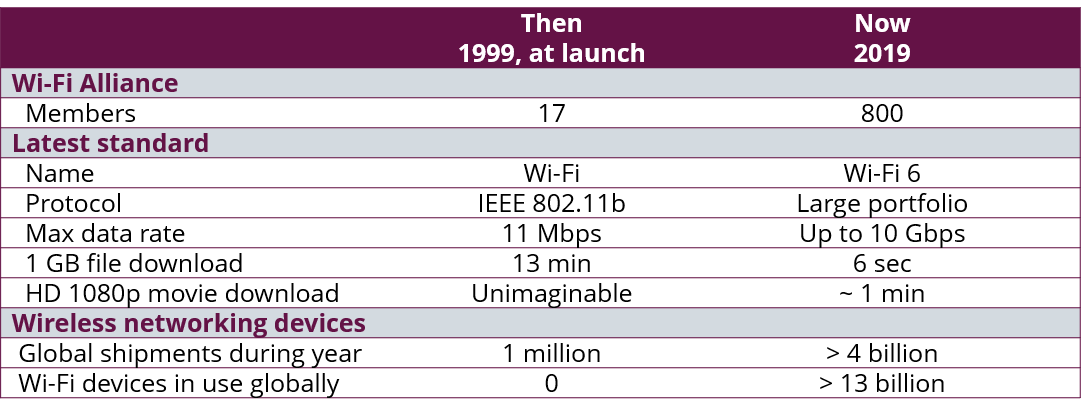Then
When the freshly minted Wi-Fi® trademark was first introduced by the Wireless Ethernet Compatibility Alliance (WECA) back in 1999, the wireless local area network (LAN) industry was already ten years old, but still in its infancy. There were wireless solutions on the market, but little interoperability between products from different vendors. The industry shipped fewer than one million devices, and nearly all of those were aimed at the enterprise market.
Earlier that year, the international standards organization, the Institute of Electrical and Electronic Engineers (IEEE), had finally approved the IEEE 802.11b standard, which specified a commercially viable wireless LAN technology at Ethernet speed. WECA was formed to ensure compatibility between products introduced into the market. The Wi-Fi trademark was created as a consumer-friendly term to assure businesses and consumers that wireless LAN products would interoperate.
Six companies initially sponsored WECA, with each one designating a board member. There was one paid technical director. The organization's management, lab testing, and public relations were all outsourced. For the WECA launch, which also announced the name Wi-Fi, eleven additional companies signed on as members.
By the time the first portfolio of Wi-Fi CERTIFIED™ products shipped seven months later, regular membership had tripled, and in 2000, year-over-year industry unit growth quadrupled. “This is the event that we have all been waiting for to drive adoption of wireless LAN technology across all market segments," said Phil Belanger, WECA’s first chairman. And it was. WECA rode the wave that it had created, and rebranded itself Wi-Fi Alliance®.
Now
In 2019, more than 13 billion Wi-Fi products can be found in nearly every corner of the globe and they will contribute nearly $2 billion in global economic value. The name Wi-Fi found its way into the dictionary ages ago, and a recent survey hailed Wi-Fi as one of the best inventions of the last quarter century.
Wi-Fi Alliance boasts a membership of more than 800 companies and employs a full-time CEO and staff. Interoperability is still a primary mission, and Wi-Fi Alliance continues to play a critical role in the evolution of the industry. Today, hundreds of professionals contribute to Wi-Fi Alliance initiatives across more than 20 different work areas.

Wind beneath our wings
The remarkable success of the Wi-Fi industry may have exceeded the dreams of even its most enthusiastic founders, but it did not happen by accident. Invisible to most outside of the industry, for 20 years, Wi-Fi Alliance has been working with the IEEE on new standards, authoring its own specifications when required, navigating industry ups and downs, and working with regulatory agencies and governments to enable the latest and greatest version of Wi-Fi to flourish.
Do you have a Wi-Fi or Wi-Fi Alliance story to tell? Let me know.
The statements and opinions by each Wi-Fi Alliance member and those providing comments are theirs alone, and do not reflect the opinions or views of Wi-Fi Alliance or any other member. Wi-Fi Alliance is not responsible for the accuracy of any of the information provided by any member in posting to or commenting on this blog. Concerns should be directed to info@wi-fi.org.




Add new comment